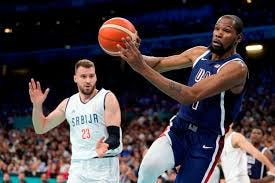Team USA requests its game back, with a smile
Continuing to recover from the disaster of 2004, the Americans look ready for a tough Olympic challenge.
How does an Olympic basketball team treat a 26-point win over Serbia? By enjoying it, oddly enough.
Kevin Durant actually grinned at least once in each half. LeBron James celebrated. Stephen Curry danced on the bench. And these were the elders, all of them older than Larry Bird was in 1992 when he became the senior U.S. men’s basketball gold medalist.
Over the past 16 years Team USA has reinvented itself, just as the game that American invented began slipping away. It also feels challenged in this tournament, and likely will have to deal with France and Victor Wembanyama on a truly hostile road court. (The French are already mad at Joel Embiid for playing with the Americans.)
Hey, it was just last week that Team USA was trailing South Sudan by 16 points in the second half of an exhibition in London. Everyone involved in this adventure knows there’s only One True Outcome, and every win must be perfectly designed and executed to pass muster. Despite the spanking of a Serbian team that had finished second in last year’s World Championships without Nikola Jokic, Team USA coach Steve Kerr had to apologize for not playing Jayson Tatum. That’s why the back-and-forth between the snubbed Jaylen Brown and Team USA president Grant Hill is not only strange but strangely comforting. Even though the risk seems far greater than the reward, it shows the best players want to be a part of this.
It wasn’t that way in 2004. The Americans had Tim Duncan, Dwyane Wade, Allen Iverson, Lamar Odom, Stephon Marbury and a rising NBA sophomore from Akron, Ohio. But they didn’t have Mike Bibby, Vince Carter, Ray Allen and Tracy McGrady. All had been on the Olympic qualifying team the previous year.
The year before that, Team USA finished sixth at the World Championships in Indianapolis. The ground was shifting under American feet. The world grasped the way the 3-point line could become a scythe, leaving defenses scattered and bleeding on the floor. That hadn’t dawned on the Americans yet. They were still driving into mosh-pit defenses and getting stuck. The revolutionary Golden State Warriors were still a few years away.
“Shooting in the NBA has become a lost art,” said 2004 coach Larry Brown, in Athens.
The Americans were drilled by Puerto Rico and also lost to Lithuania before they reached the money games. A win over Spain put them in the medal round, but Argentina and Manu Ginobili knocked them out, 85-81. It took an admirable effort for the U.S. to salvage bronze against Lithuania.
“This is a totally different game,” said Donnie Nelson, who at the time was on Lithuania’s coaching staff. “To play it, you have to pass, shoot and move without the ball. That’s something that has been lost.”
For the tournament, the U.S. shot 31.4 percent from the 3-point line. Only one team, Spain, was worse. Ironically, the Argentine gold medalists also shot 31.4 percent. Lithuania shot 46.8.
It was the first and only time the Americans pros had failed to bring home gold, and it happened just 12 years after the Dream Team sailed through Barcelona without even having to call time out. Intolerable, and Team USA pledged to start taking international play seriously, handing over the coaching to Mike Krzyzewski, structuring a plan for the non-Olympic years, building a line of succession that would give younger players a taste of what could come, generally setting several alarm clocks to rouse the giant. Because Krzyzewski had recruited most, if not all, of the U.S. roster while at Duke, and because he wasn’t coaching in the NBA against them, he had a better chance of persuading them to play. James probably would have gone to Duke, for a season, under today’s NBA entry rules. By 2008 he was clearly the NBA’s best player, and Kobe Bryant, who also strongly considered Duke, was the eminence grise and a fearsome source of peer pressure.
The “Redeem Team” won in Beijing and has won three more golds since, including 2021 in Tokyo, when James, Curry, Klay Thompson, Kyrie Irving and James Harden were hurt or declined the opportunity, and when Covid-19 disruptions pushed the NBA playoffs into what would have been Olympic training camp. The only real big men on the roster was Bam Adebayo and Javale McGee. The Americans lost to France in pool play but evened the score in the gold medal game. To this day, no one recognizes how remarkable that gold medal was, although coach Gregg Popovich would be happy to remind you.
By then the NBA had modernized, the same way Ford and GM had borrowed the methods that Toyota used to cause their near-destruction. Today’s young players, like Anthony Edwards, can still dance on air, but the main thing they can do is shoot. Durant, of course, always could. Against Serbia he hit all five 3-pointers and was 8-for-9 overall, and the team shot 58 percent on 3-point shots, which in the Games are about a foot and a half shorter than in the NBA. James, five months shy of his 40th birthday, had 21 points, seven rebounds and nine assists.
There are 81 players in the men’s tournament with NBA experience. In 1992 there were 22, and eleven of them were on the Dream Team. Another match with South Sudan looms on Wednesday, but the theoretical medal-round games with the stocked Canadians and the inspired French are the Alps in the background, getting closer and more imposing. Whether somebody can remove Durant’s smile and restore his customarily glum NBA expression is an open question. At the moment it might not be wise to bet against the Gleam Team.



